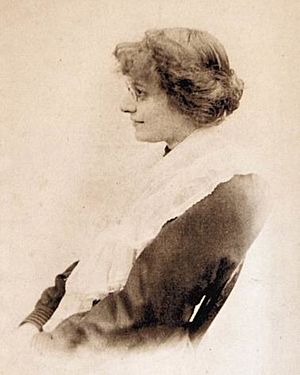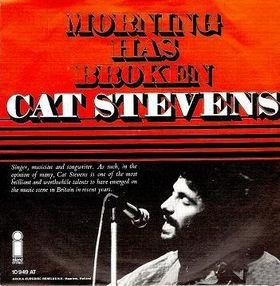Morning Has Broken facts for kids
Quick facts for kids Morning Has Broken |
|
|---|---|
| by same composer as for Bunessan | |

Eleanor Farjeon
|
|
| Genre | Christian hymn |
| Text | Eleanor Farjeon |
| Language | English |
| Meter | 5.5.5.4 D |
| Melody | Bunessan (hymn tune) |
| Performed | 1931 |
"Morning Has Broken" is a well-known Christian hymn. It was first shared with the public in 1931. The words were written by an English author named Eleanor Farjeon. She was inspired by the peaceful village of Alfriston in East Sussex, England. The song's melody comes from a traditional Scottish Gaelic tune called "Bunessan". This hymn is often sung in church services for children and also at funeral services.
A famous English pop and folk singer, Cat Stevens, recorded his own version of the song. It was part of his album Teaser and the Firecat in 1971. Because of how popular his recording became, many people started to connect the song with Cat Stevens. His version became a big hit. It reached number six on the U.S. Billboard Hot 100 music chart. It also hit number one on the U.S. easy listening chart in 1972. In Canada, it reached number four on the RPM magazine charts.
How the Hymn Began
This hymn first appeared in the second edition of a songbook called Songs of Praise. This book was published in 1931. The hymn was set to the tune "Bunessan," which was created in the Scottish Islands.
The editor of Songs of Praise, Percy Dearmer, explained something interesting. He said they needed a hymn to give thanks for each new day. So, they asked English poet and children's author Eleanor Farjeon to write a poem. Her poem was made to fit the beautiful Scottish tune.
Eleanor Farjeon also wrote a slightly different version of the hymn. It appeared as a poem in a collection called Children's Bells. She gave it a new title: "A Morning Song (For the First Day of Spring)." This collection was published in 1957.
The tune "Bunessan" was also used for other hymns. For example, it was paired with "Child in the Manger." This nativity song was written by Scottish poet Mary MacDonald. She lived on the Isle of Mull, near the village of Bunessan. The tune is named after this village. "Bunessan" is also used for hymns by James Quinn. These include "Christ Be Beside Me" and "This Day God Gives Me."
Cat Stevens' Famous Recording
| "Morning Has Broken" | ||||
|---|---|---|---|---|
 |
||||
| Single by Cat Stevens | ||||
| from the album Teaser and the Firecat | ||||
| Released | 7 January 1972 | |||
| Recorded | March 1971 | |||
| Studio | Morgan Studios, London | |||
| Genre | Folk rock, soft rock, gospel | |||
| Length | 3:20 | |||
| Label | Island | |||
| Songwriter(s) |
|
|||
| Producer(s) | Paul Samwell-Smith | |||
| Cat Stevens singles chronology | ||||
|
||||
Cat Stevens' recording of "Morning Has Broken" made the song known all over the world. A talented musician named Rick Wakeman created and played the piano part.
When Cat Stevens was getting ready to record the song, it was very short. It took only about 45 seconds to sing the basic hymn. His producer, Paul Samwell-Smith, told him it needed to be longer for an album. It had to be at least three minutes long.
Stevens heard Wakeman playing something beautiful in the recording studio. It was a rough idea for a piece called "Catherine Howard." Stevens really liked it. He asked Wakeman if he could use something similar for the beginning, middle, and end of "Morning Has Broken." Wakeman first said no because it was for his own album. But Stevens convinced him to adapt his music for the hymn.
In the year 2000, Rick Wakeman released his own instrumental version of "Morning Has Broken." It was on an album with the same title. That same year, he shared in an interview that he had agreed to play on Cat Stevens' song for £10. He was upset that his name was not included in the song's credits. He also said he never received the money.
Later, when Cat Stevens returned to music as Yusuf Islam, he paid Wakeman. He also apologized for the original mistake. He explained that it was due to confusion from the record company. In a TV show, Wakeman said he felt Stevens' version of "Morning Has Broken" was a very beautiful song. He believed it helped people feel closer to religious truth. He was happy to have been a part of it. Wakeman included a version of the song on his 2017 piano album, Piano Portraits.
The Cat Stevens arrangement of the song changes musical keys several times. The first, second, and fourth verses are played in the key of C major. The musical introduction, the third verse, and the ending are played in D major.
Other Artists and Versions
Many other artists have recorded "Morning Has Broken." Some of these include The New Seekers, Judy Collins, Neil Diamond, and Art Garfunkel. The Mormon Tabernacle Choir and Nana Mouskouri have also recorded it. Even David Gilmour from Pink Floyd played it during one of his online live streams.
In November 2008, the Teaser and the Firecat album was re-released. This special deluxe CD version included an early demo recording of "Morning Has Broken."
The song has also been translated into many different languages. For example, in German, it's called "Schön ist der Morgen." In French, it's "Matin brisé." There's also a Dutch version called "Licht Op De Lakes."

